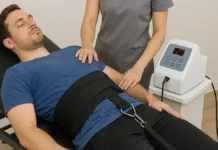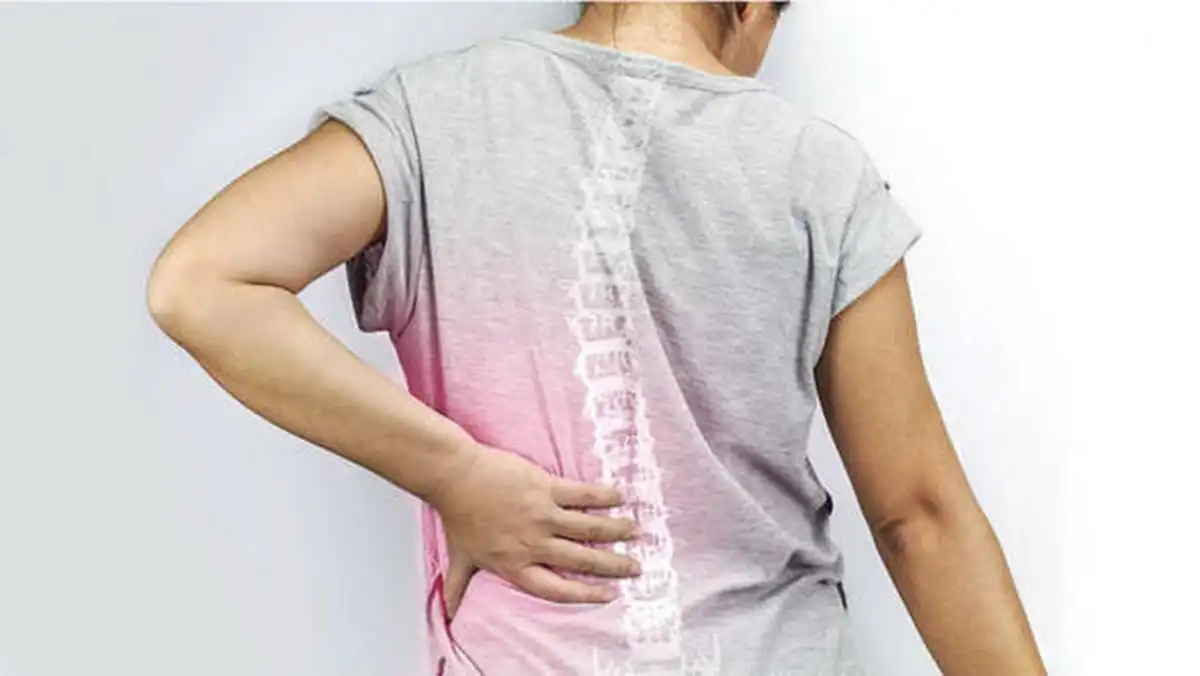Piriformis syndrome, although often associated with pain in the glutes and lower back, can also affect pregnant women. During pregnancy, the body undergoes significant anatomical and hormonal changes, which can influence the occurrence of this syndrome.
When Baby Gets on Your Nerve: Understanding Piriformis Syndrome During Pregnancy
Pregnancy profoundly transforms the posture, biomechanics, and neuromuscular balance of the female body. While these adjustments are physiological and necessary, they can also cause discomfort or pain, particularly in the pelvis and sciatic nerve. Among the possible causes, piriformis syndrome is a little-known but common condition resulting from compression of the sciatic nerve by a small pelvic muscle: the piriformis.
The piriformis plays a discreet but fundamental role in stabilizing the pelvis and externally rotating the hip. During pregnancy, this muscle is subjected to unusual mechanical stresses , linked to the evolution of the center of gravity, weight gain, and postural adaptations. As the uterus increases in size, the overall posture changes: lumbar lordosis increases, the pelvis tilts, and tensions are redistributed throughout the pelvic girdle. The piriformis, located deep in this region, can then become hypertonic or spasmed, compressing the sciatic nerve which passes in the immediate vicinity.
The resulting pain is typically located in the buttock , sometimes radiating to the thigh or leg, simulating sciatica. However, unlike sciatica of disc origin, piriformis sciatica is not always associated with neurological disorders such as loss of strength or sensation. It can be triggered or aggravated by prolonged standing, climbing stairs, or certain sitting positions.
This particular clinical picture calls for a detailed understanding of the physiology of pregnancy . The musculoskeletal system is influenced not only by mechanical stress, but also by hormonal fluctuations , which alter tissue flexibility and joint stability. The piriformis may thus be forced to compensate more, becoming the weak link in a complex chain of adaptation.
It’s not just a “temporary ailment” to be tolerated. Recognizing the signs of piriformis syndrome in pregnant women allows for early, gentle action, using manual, postural, and functional approaches that respect the changing body. It is in this perspective that osteopathy can play an essential role, by rebalancing tension, restoring mobility, and preserving the comfort of the pregnancy as a whole.
During pregnancy, the body must adapt to many postural changes. The center of gravity shifts forward. The lumbar and cervical curves become more pronounced, and the back and shoulders round. The pelvis tilts backward.
The hormone relaxin, secreted by the ovaries and uterus, will work to relax the joints, thus facilitating the baby’s delivery. Because of this joint relaxation, the piriformis will have to work harder to keep the pelvis together. In pregnant women, it is common to feel discomfort in the buttocks that travels down the leg.
⚠️This content is provided for educational purposes only and is not a substitute for professional medical advice. It is strongly recommended that you do not perform any maneuvers, exercises, or treatments mentioned in this article without the guidance of a qualified healthcare professional. Improper application may result in injury or complications. It is essential to consult a specialist for an assessment specific to your situation.
The Piriformis Muscle and Sciatica in Pregnancy: Mechanisms and Issues
During pregnancy, a woman’s body undergoes profound hormonal, postural, and biomechanical changes. Piriformis syndrome is a common musculoskeletal disorder, particularly when it causes compression of the sciatic nerve. This neuromuscular disorder can cause radiating and sometimes disabling pain that affects the quality of life of expectant mothers.
The piriformis muscle is a small, deep muscle located in the pelvic region. It originates on the anterior surface of the sacrum, near the sacroiliac joints, and inserts onto the greater trochanter of the femur. Its main function is to laterally rotate the thigh and stabilize the hip joint. The sciatic nerve , the longest in the human body, passes just below—and sometimes through—this muscle. In some cases, prolonged contraction or inflammation of the piriformis can cause compression of this nerve.
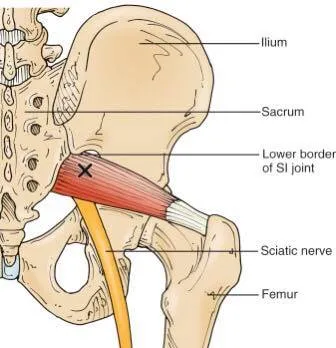
In pregnant women, several factors can contribute to this syndrome. Increased relaxin , a hormone that relaxes connective tissue to prepare the pelvis for childbirth, can also make the piriformis muscle more unstable or more stressed. In addition, changes in posture , due to a shift in the center of gravity, can increase tension in the pelvic area and promote overwork of the piriformis. This results in pain often felt in the buttock, which can radiate down the leg, mimicking classic sciatica.
The pain can become sharp, throbbing, or even unbearable , especially when sitting or walking. Numbness , a burning sensation , or muscle weakness may also develop if nerve compression persists.
The osteopathic approach is particularly relevant in this context. Through gentle techniques of myofascial release, joint mobilization or postural correction, the osteopath can reduce tension in the piriformis , restore pelvic mobility and relieve nerve compression. The goal is to reduce pain , prevent recurrences , and support bodily adaptations related to pregnancy .
It is essential not to let symptoms linger . Prompt and appropriate treatment often helps prevent the problem from becoming chronic and provides the expectant mother with much-needed comfort during this delicate period.
Pathophysiology of piriformis syndrome
Pathophysiology refers to the study of the functional changes that occur in the body as a result of a disease or pathological condition. It combines aspects of pathology (the study of the causes and effects of diseases) with physiology (the study of how the body and its systems function).
The pathophysiology of piriformis syndrome in pregnant women is linked to specific anatomical and hormonal changes that occur during pregnancy.
Here is an overview of the pathophysiology of this particular condition:
- Sciatic Nerve Compression: The piriformis muscle is located near the sciatic nerve, the longest nerve in the body. During pregnancy, the expanding uterus puts pressure on surrounding structures, including the piriformis muscle and sciatic nerve. This compression can lead to irritation or inflammation of the nerve.
- Hormonal Changes: During pregnancy, the body produces hormones such as relaxin, which aim to relax the pelvic ligaments and muscles to facilitate the expansion of the uterus and the passage of the baby during childbirth. However, this muscle relaxation can also affect the stability of the pelvic region, which may contribute to compression of the sciatic nerve by the piriformis muscle.
- Postural Changes: Changes in center of gravity and posture are common during pregnancy to accommodate the growing uterus. These changes can lead to increased pressure on the lumbar and pelvic region, contributing to irritation of the piriformis muscle and sciatic nerve.
- Weight Management: Weight gain during pregnancy, particularly in the abdominal region, can place additional pressure on the spine and lumbar region, increasing the risk of irritation of the piriformis muscle and sciatic nerve.
- Prolonged Sitting: Prolonged sitting is common during pregnancy, whether at work or at home. This position can increase pressure on the piriformis muscle, worsening the symptoms of the syndrome.
- Increased Muscle Demand: The pelvic muscles may be used more during pregnancy due to changes in posture and the need to provide increased support for the added weight.
In summary, piriformis syndrome in pregnant women often results from a combination of sciatic nerve compression by the piriformis muscle, pregnancy-induced hormonal changes, postural changes, and weight management.
Why Does the Piriformis Become Inflamed? Deciphering the Mechanisms During Pregnancy
- Sciatic Nerve Compression: The piriformis muscle passes just above the sciatic nerve, which is the longest nerve in the body. Physiological changes associated with pregnancy, such as pressure from the expanding uterus on surrounding structures, can compress the sciatic nerve and contribute to piriformis syndrome.
- Hormonal Changes: During pregnancy, the body produces hormones, notably relaxin, which function to relax the ligaments and pelvic muscles to allow the expansion of the uterus. However, it can also affect the stability of the pelvic region, thus promoting compression of the sciatic nerve by the piriformis muscle.
- Postural Changes: Changes in center of gravity and posture during pregnancy can put increased pressure on the lumbar and pelvic region, contributing to irritation of the piriformis muscle and sciatic nerve.
- Increased Load on the Lower Back: Weight gain during pregnancy, especially in the abdominal region, can increase the load on the spine and lumbar region, which can influence piriformis syndrome.
- Increased Muscle Activity: The pelvic muscles may be used more during pregnancy due to changes in posture and the increased need for support for the added weight.
- Prolonged Sitting: Prolonged sitting, common during pregnancy, can put pressure on the piriformis muscle, worsening the symptoms of the syndrome.
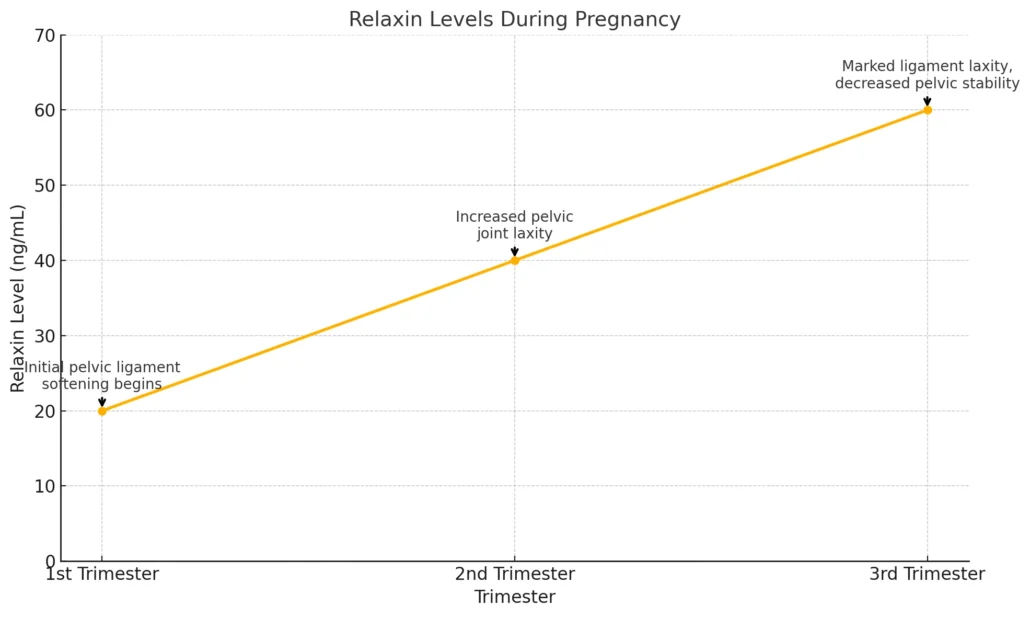
This graph illustrates the evolution of relaxin levels during the three trimesters of pregnancy. Produced mainly by the ovaries and placenta, relaxin is a key hormone in the female body’s adaptation to gestation. From the first trimester, its action begins to relax the pelvic ligaments in preparation for childbirth. In the second trimester, the increase in relaxin levels leads to increased relaxation of the ligamentous structures, particularly in the pelvis. This hyperlaxity becomes more pronounced in the third trimester, reducing pelvic stability. This hormonal change, although physiological, can make certain muscles—such as the piriformis—more vulnerable to overload and irritation. This weakening of the ligaments, combined with the shift in the center of gravity, contributes to the development of piriformis syndrome in some pregnant women. This link between relaxin and pelvic instability is a key factor to consider in perinatal osteopathy.
Recognizing the Signs: Typical Pains of Piriformis Syndrome
- Pain in Buttocks: Pain may be felt in the buttocks area, usually on one side only. This pain can be described as deep and throbbing.
- Lower Back Pain: Pain can radiate to the lower back, especially on the side where the piriformis muscle exerts pressure on the sciatic nerve.
- Pain Along the Sciatic Nerve: Pain can follow the path of the sciatic nerve, going down the back of the thigh and sometimes to the calf or foot.
- Numbness and Tingling: Sensations of numbness, tingling, or weakness may be felt along the sciatic nerve.
- Pain Worsened by Movement: Pain may worsen with certain activities, such as walking, sitting for prolonged periods, or certain specific movements.
- Pain When Sitting: Sitting can make symptoms worse, as it can increase the pressure exerted by the piriformis muscle on the sciatic nerve.
- Difficulty Walking: Symptoms can make walking difficult, especially if the pain is severe.
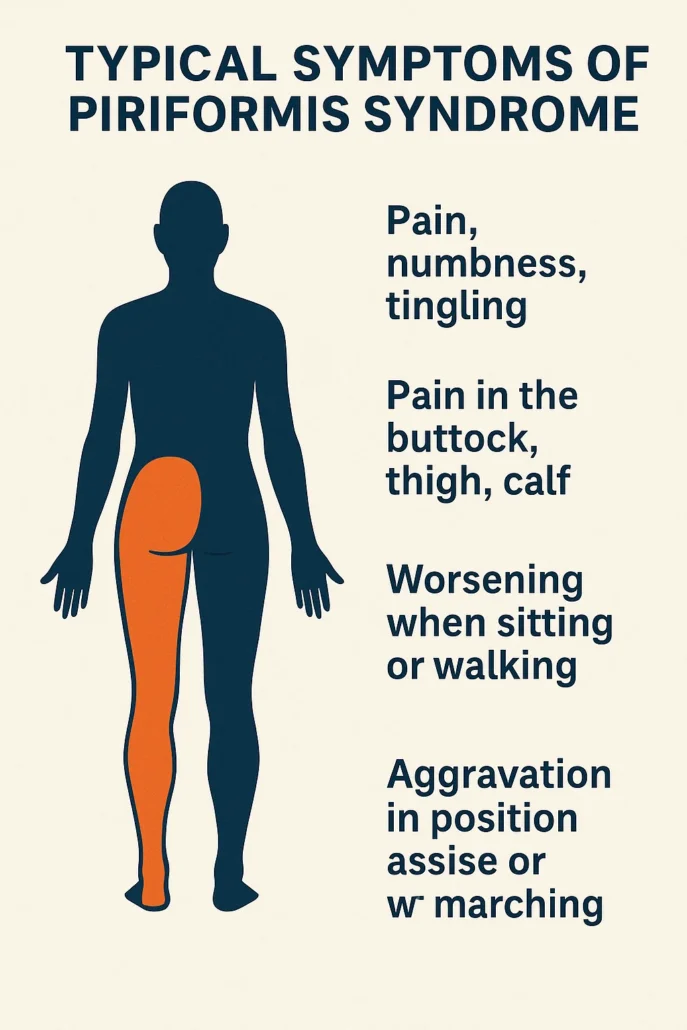
Osteopathy to the Rescue of the Piriformis: Global Approach and Therapeutic Techniques
Piriformis syndrome is a common source of gluteal pain radiating into the thigh or calf, often mistaken for sciatica. It results from compression of the sciatic nerve by a tense, shortened, or spasmed piriformis muscle. While physical therapy and stretching are often recommended, osteopathy offers a fine-tuned, manual approach , incorporating precise neuromuscular techniques.
Here is how the osteopath can intervene effectively, with step-by-step illustrated techniques , focused on relief, neuromuscular release and restoration of movement.
Step 1 – Locate the Culprit: Palpatory Assessment of the Piriformis
Before any technique, it is essential to manually locate the piriformis . The patient is placed in a ventral decubitus position , with the feet slightly turned outwards.
- The practitioner locates the lateral sacral fossa (near the lateral border of the sacrum) and follows a diagonal line toward the greater trochanter .
- Palpation should be slow and deep to detect tension in the piriformis muscle and the possible presence of trigger points .
Step 2 – Trigger Point Release: Relaxing Myofascial Tension
Objective : to deactivate a hyperirritable myofascial point responsible for referred pain.
Patient position : prone , hip in slight internal rotation.
Steps :
- Locate the trigger point by slow, deep palpation. A painful fibrous nodule is detected.
- Apply ischemic pressure with the thumb or knuckles, gradually increasing , to a tolerable pain level (usually 6-7/10).
- Maintain pressure for 30 to 90 seconds , until the patient feels a reduction in pain or a “letting go.”
- Slowly release the pressure.
- Perform a gentle piriformis stretch (e.g., flexed hip, controlled external rotation).
💡 Tip: This technique can be supplemented by applying local heat or a vapo-glacial spray to improve relaxation.
Step 3 – Positional Technique: Reprogramming Pain through Comfort
Objective : to inhibit the proprioceptive reflexes which keep the muscle in contracture.
Patient position : lateral decubitus , painful side upwards.
Steps :
- Palpate the sensitive point of the piriformis .
- Bring the top leg into hip flexion, abduction and external rotation until you achieve a 70% reduction in pain at the palpated point.
- Maintain this comfortable position for 90 seconds , without continuous pressure on the point.
- Slowly return to neutral position without active contraction of the patient .
- Revalidate the point sensitivity.
📌 Benefits: gentle, safe and very effective for sensitive or hyperalgic patients.
Step 4 – Myofascial Release: Freeing Movement Deeply
Objective : To restore fascial mobility and reduce tissue density.
Patient position : ventral or lateral decubitus .
Steps :
- Place both hands flat on either side of the piriformis, using the gluteus maximus as the upper reference point.
- Apply gentle but firm pressure , perpendicular to the muscle, then twist ( longitudinal traction + transverse sliding).
- Follow tissue movements: the practitioner lets his hands “melt” in the direction of least resistance.
- Continue until you feel spontaneous release (approximately 1 to 3 minutes).
- Then check the hip rotation mobility, which is sometimes already improved.
After the Session: Stretching, Posture and Daily Prevention
After manual techniques, the patient can benefit from:
- Guided piriformis stretches (seated, lying down, or modified yoga pigeon position).
- Strengthening the lateral hip rotators to prevent recurrence.
- Postural advice (avoid the crossed-legged position, adapt your sitting position).
The osteopath will also assess pelvic, sacroiliac, or lumbar imbalances that contribute to piriformis syndrome. A comprehensive approach is essential to avoid treatment being solely symptomatic.
Stories of Relief: Two Pregnant Women’s Journeys
Case Study 1: Relaxation of the Piriformis and Psoas to Relieve Pain in Mrs. L
Mrs. L, 32 years old, pregnant with her second child, consulted an osteopath because of severe pain in her lower back, buttocks and right leg. She also complained of frequent headaches. Initial examination revealed significant tension in the piriformis muscle, causing compression of the sciatic nerve.
The osteopath developed a treatment plan that included specific piriformis and psoas release techniques. When assessing Mrs. L’s posture, the osteopath noted a modified cervical curve, accompanied by tension in the suboccipital region.
Over several sessions, the osteopath worked on relaxing the piriformis, thus relieving nerve compression. Additionally, specific techniques were applied to release the tight psoas. The osteopath also took into account postural changes due to pregnancy, working on the suboccipital region to relieve frequent headaches.
After several weeks of treatment, Ms. L reported a marked improvement in her lower back, buttocks and leg pain. Headaches were less frequent, and she noticed better overall mobility.
Case Study 2: A Comprehensive Approach for Mrs. G and Her Headaches
Mrs. G, 28, pregnant with her first child, sought help from an osteopath due to persistent headaches. Initial examination revealed significant tension in the cervical region, particularly in the suboccipital region. Additionally, low back and pelvic pain were present.
The osteopath adopted a global approach, taking into account the pregnancy, by working on the relaxation of the piriformis and the psoas. By assessing Mrs. G’s posture, the osteopath identified postural changes linked to pregnancy.
Release techniques were applied to the cervical region, relieving tension in the suboccipital region. The osteopath also provided advice on posture and exercises to strengthen the supporting muscles.
Over the course of the sessions, Mrs. G noticed a significant improvement in her headaches, and her lower back and pelvic pain also decreased. She continued to attend regular sessions to support her pregnancy and maintain her well-being.
These case studies illustrate how a comprehensive osteopathic approach, including treatment of the piriformis, psoas, and pregnancy-specific adjustments, can help relieve pain in pregnant women.
10 Keys to a Healthy Pelvis During Pregnancy
- Pelvic Muscle Strengthening Exercises: Incorporate specific exercises to strengthen the pelvic muscles, including the piriformis muscle. Targeted exercises can help maintain pelvic stability and prevent sciatic nerve compression.
- Regular Stretches: Practice gentle stretches, focusing on the pelvic region and lower back. Regular stretching can help relieve muscle tension and prevent discomfort associated with piriformis syndrome.
- Maintaining Good Posture: Adopt correct posture to reduce pressure on the lower back and pelvic region. Use support cushions if necessary to maintain a comfortable position, especially during prolonged sessions.
- Adequate Hydration: Make sure you stay well hydrated throughout the day. Adequate hydration promotes tissue flexibility and can help prevent muscle tension.
- Balance Between Physical Activity and Rest: Adopt a physical activity program adapted to pregnancy, including moderate exercises such as walking or swimming. Also be sure to allow enough rest time to allow your body to recover.
- Weight Management: Maintain appropriate body weight during pregnancy. Excessive weight can put extra strain on your lower back and pelvic muscles.
- Regular Medical Consultation: Carry out regular medical consultations to monitor the pregnancy. Tell your healthcare professional about any discomfort or pain for personalized advice.
- Relaxation Techniques: Incorporate relaxation techniques such as meditation, deep breathing or prenatal yoga. These methods can help reduce stress and promote physical and emotional well-being.
- Use of Support Cushions: When seated, use support cushions to maintain a comfortable position and reduce pressure on the pelvic area.
- Comfortable Shoes: Choose shoes that are comfortable and supportive. This can help maintain a balanced posture and reduce pressure on the joints.
They Testify: When Osteopathy Changes a Pregnancy
Mrs. G – “When piriformis syndrome struck, my pregnancy became an ordeal. Every movement was a searing pain, and I felt almost bedridden. It was then that a friend recommended an exceptional osteopath to me, who, moreover, came to my home.
From his first visit, the osteopath established a climate of trust with his gentleness and professionalism. By understanding my ailments and the challenges of pregnancy, he adapted his techniques to my specific needs. His expert hands identified areas of tension, particularly in the piriformis muscle, and began to ease the pain.
The fact that the osteopath came to my home was a real relief. In the privacy of my home, I was able to relax more, promoting more effective treatment. The regular sessions have been a lifesaver. Little by little, the pain gave way, allowing the joy of pregnancy to take over.
Today, with a healthy baby in my arms, I am grateful to this osteopath who changed the course of my pregnancy. His dedication, understanding and expertise made this experience much more bearable. For all the mothers-to-be who feel trapped in pain, osteopathy at home could be the answer to your prayers. »
They Testify: When Osteopathy Changes a Pregnancy
The positional release technique for the piriformis muscle can be performed using a specific position to reduce pressure on the sciatic nerve. Here’s one method you could try, but keep in mind that every person is different, and it is always recommended to consult a healthcare professional before beginning any exercise or treatment program. In case of pregnancy, also make sure that the position is comfortable and safe for the health of the mother and baby.
Lying on your back position
- Lie on your back on a firm surface, such as a yoga mat or bed.
- Bend your knees and place your feet on the surface, hip-width apart.
- Lift the affected leg (the side where you feel the symptoms) and bend the knee to about a 90-degree angle.
- Cross the ankle of the raised leg over the knee of the other leg, forming a position similar to the letter “4”.
- Hold this position and breathe deeply to promote relaxation.
Duration: Hold the position for 1 to 2 minutes, or as long as you feel comfortable. You can repeat this position several times a day.

Additional Tips:
- If you experience severe pain or discomfort, stop the position immediately and consult a healthcare professional.
- You can use a cushion under your head for added comfort.
- If possible, practice this technique on a firm surface for best support.
This technique aims to stretch the piriformis muscle and relieve pressure on the sciatic nerve. However, each person reacts differently, and it is always recommended to consult a healthcare professional for advice tailored to your specific situation. If you are pregnant, make sure this position is safe and comfortable during pregnancy.
Sitting position on a chair :
- Sit comfortably in a chair with your back straight and your feet flat on the floor.
- Make sure the chair is stable and you can sit with a comfortable posture.
- Lift the affected leg and place the ankle of that leg on the opposite knee, forming a position similar to the letter “4.”
- You can apply light pressure to the raised knee with the hand on the opposite side to gently increase the stretch, but don’t force it.
- Keep your back straight and breathe deeply to promote relaxation.
- Hold this position for 1 to 2 minutes, or as long as you feel comfortable.
- Repeat on the other side if necessary.
Additional Tips:
- Make sure the chair is stable, and that you do not feel any severe pain or discomfort during the stretch.
- If you have back or hip problems, adapt the position according to your comfort.
- Don’t force the stretch, and stay within a range of motion that suits you.

This chair-sitting technique also aims to stretch the piriformis muscle and relieve pressure on the sciatic nerve. As always, if you have specific concerns or experience unusual pain, consult a healthcare professional before continuing or adjusting any stretching or relief technique.
Myofascial Release Technique for the Piriformis Using a Tennis Ball
Myofascial release (MFR) is a technique used to alleviate tension and tightness in the myofascial tissues, which are the tough membranes that wrap, connect, and support your muscles. One effective method for performing MFR on the piriformis muscle is using a tennis ball. This self-massage technique can help relieve pain and discomfort associated with piriformis syndrome. Here’s a step-by-step guide:
Materials Needed:
- A tennis ball
- A yoga mat or carpeted floor for comfort
Steps:
- Find a Suitable Area:
- Choose a flat, comfortable surface like a yoga mat or carpeted floor where you can lie down and have enough space to move around.
- Locate the Piriformis Muscle:
- The piriformis muscle is located in the buttock region, deep to the gluteal muscles. To find it, locate the bony prominence of your hip (greater trochanter) and the base of your spine (sacrum). The piriformis muscle lies between these two points.
- Position the Tennis Ball:
- Sit on the floor with your legs extended. Place the tennis ball under your buttock on the side where you are experiencing discomfort.
- Slowly lower yourself onto the ball, positioning it directly under the piriformis muscle.
- Apply Pressure:
- Gently lean into the tennis ball to apply pressure to the piriformis muscle. You should feel a moderate amount of pressure but not intense pain.
- If the pressure is too intense, support your weight with your hands and the opposite foot to decrease the load.
- Perform Gentle Movements:
- Roll back and forth slowly over the tennis ball, allowing it to massage the muscle. Focus on areas where you feel tightness or tenderness.
- You can also make small circular motions or shift your weight side to side to target different parts of the muscle.
- Hold and Breathe:
- When you find a particularly tight or tender spot, pause and hold the pressure on that spot. Breathe deeply and try to relax the muscle as much as possible.
- Hold for 20-30 seconds or until you feel the muscle release.
- Repeat as Needed:
- Continue to roll and hold on different spots of the piriformis muscle for about 5-10 minutes.
- Repeat on the other side if necessary, even if you do not feel pain there, to maintain muscle balance.
- Post-Release Stretch:
- After performing MFR, it’s beneficial to stretch the piriformis muscle. A simple stretch involves lying on your back, crossing one leg over the opposite knee, and gently pulling the bottom knee toward your chest.
Tips:
- Consistency: Perform this technique regularly, especially if you suffer from chronic piriformis syndrome or have a sedentary lifestyle.
- Warm-Up: Consider doing a light warm-up before MFR, such as walking or gentle stretching, to increase blood flow to the muscles.
- Listen to Your Body: Avoid causing excessive pain. The pressure should be enough to feel the muscle release, not to cause discomfort or bruising.
Using a tennis ball for myofascial release of the piriformis can be a highly effective method to alleviate tightness and discomfort. This simple, cost-effective technique can be easily incorporated into your daily routine to help manage symptoms and improve muscle function.
Caution: Avoid direct pressure on the sciatic nerve, which passes below the piriformis. If you feel sharp pain or discomfort radiating down the leg, adjust the pressure or discontinue the technique.

Remember that myofascial release techniques must be performed with awareness and respecting your body’s responses. If pain persists, it is recommended to seek advice from a healthcare professional or qualified manual therapist who can provide personalized advice and interventions.
References
- Siddiq MAB. Piriformis Syndrome and Wallet Neuritis: Are They the Same? Cureus. 2018 May 10;10(5):e2606. [PMC free article] [PubMed]
- Chang A, Ly N, Varacallo M. StatPearls [Internet]. StatPearls Publishing; Treasure Island (FL): Feb 12, 2022. Piriformis Injection. [PubMed]
- Cassidy L, Walters A, Bubb K, Shoja MM, Tubbs RS, Loukas M. Piriformis syndrome: implications of anatomical variations, diagnostic techniques, and treatment options. Surg Radiol Anat. 2012 Aug;34(6):479-86. [PubMed]
- Smoll NR. Variations of the piriformis and sciatic nerve with clinical consequence: a review. Clin Anat. 2010 Jan;23(1):8-17. [PubMed]
- Huang ZF, Yang DS, Shi ZJ, Xiao J. [Pathogenesis of piriformis syndrome : a magnetic resonance imaging-based comparison study]. Zhonghua Yi Xue Za Zhi. 2018 Jan 02;98(1):42-45. [ PubMed ]
- Hopayian K, Danielyan A. Four symptoms define the piriformis syndrome: an updated systematic review of its clinical features. Eur J Orthop Surg Traumatol. 2018 Feb;28(2):155-164. [PubMed]
- Misirlioglu TO, Palamar D, Akgun K. Letter to the editor involving the article ‘Piriformis muscles syndrome: A cross-sectional imaging study in 116 patients and evaluation of therapeutic outcome’. Eur Radiol. 2018 Dec;28(12):5354-5355. [PubMed]
- Ro TH, Edmonds L. Diagnosis and Management of Piriformis Syndrome: A Rare Anatomic Variant Analyzed by Magnetic Resonance Imaging. J Clin Imaging Sci. 2018;8:6. [PMC free article] [PubMed]
- Safarpour Y, Jabbari B. Botulinum toxin treatment of pain syndromes -an evidence based review. Toxicon. 2018 Jun 01;147:120-128. [PubMed]
- Nazlıkul H, Ural FG, Öztürk GT, Öztürk ADT. Evaluation of neural therapy effect in patients with piriformis syndrome. J Back Musculoskelet Rehabil. 2018;31(6):1105-1110. [PubMed]
- Cass SP. Piriformis syndrome: a cause of nondiscogenic sciatica. Curr Sports Med Rep. 2015 Jan;14(1):41-4. [PubMed]
- Vassalou EE, Katonis P, Karantanas AH. Piriformis muscle syndrome: A cross-sectional imaging study in 116 patients and evaluation of therapeutic outcome. Eur Radiol. 2018 Feb;28(2):447-458. [PubMed]






